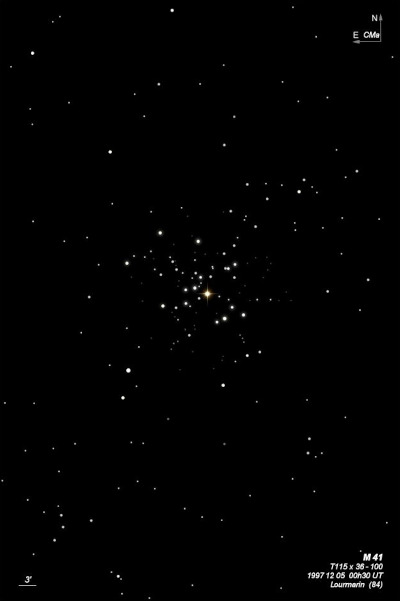
Giovanni Hodierna discovered M41 = NGC 2287 = h411 in 1654, using a small refractor at 20x. It was independently discovered by John Flamsteed on 16 Feb 1702: "Near this star (12 CMa), there is a cluster." Le Gentil also found it in 1749. Wolfgang Steinicke credits Aristotle with a naked-eye discovery about 325 based on comments by J.E. Gore in his 1902 review of the Messier objects. But the source material is not very reliable. See http://seds.org/messier/more/m041_ari.html for this possibility.
William Herschel recorded M41 in 1784 as "A large cluster of very coarsely scattered large [bright] stars." and in Mar 1830 John Herschel called M41 "Coarse; fills field. The chief, 8m, is red; a poor cluster." The position in the NGC, RNGC and NGC 2000 is 1 tmin of RA too far east.
200/250mm - 8" (10/4/80): ~60 stars mag 7-11.5, very bright, very large, very rich, includes 10 bright stars mag 7 and 8. Many of the stars are arranged in curving rows and groups, includes several double stars. Located about 20' NW of mag 6.0 12 Canis Majoris. Naked-eye object in dark sky.
400/500mm - 18" (2/14/10): this naked-eye cluster was perfectly framed at 73x with the 31mm Nagler (67' field). M41 extends roughly 35' in diameter though many of the brighter mag 7 and 8 stars are in a smaller central region. The cluster includes roughly a dozen brighter stars, many forming a large central oval ~15'-20' diameter and elongated E-W or SW-NE. Near the center is a richer grouping with a number of fainter stars and two bright stars including orange (K3-class) mag 6.9 HD 49091 (brightest member).
A number of loops and chains appear to spin out from the central grouping. One long chain extends NNW to the edge of the cluster and a shorter nearby chain heads WNW and includes a pretty equal mag pair before bending abruptly SW. Two other chains extend from the center to the SW and ENE. About 20' SE of the center of the cluster is mag 6.1 HD 49333, the brightest star in the field though not a member.
Naked-eye - (numerous times): fairly easy naked-eye glow in a dark sky.
Notes by Steve Gottlieb